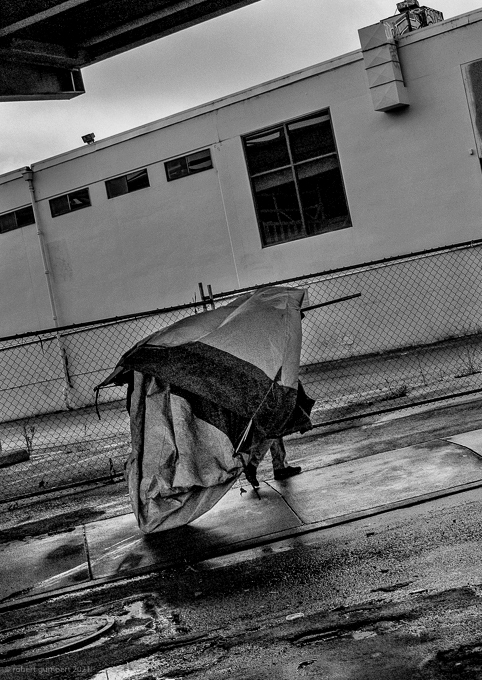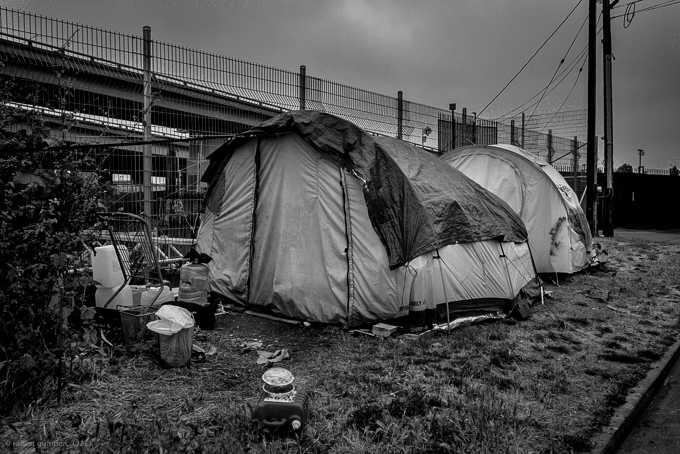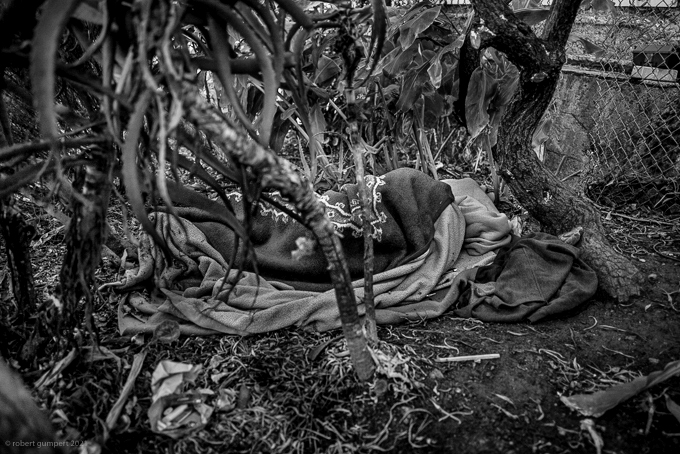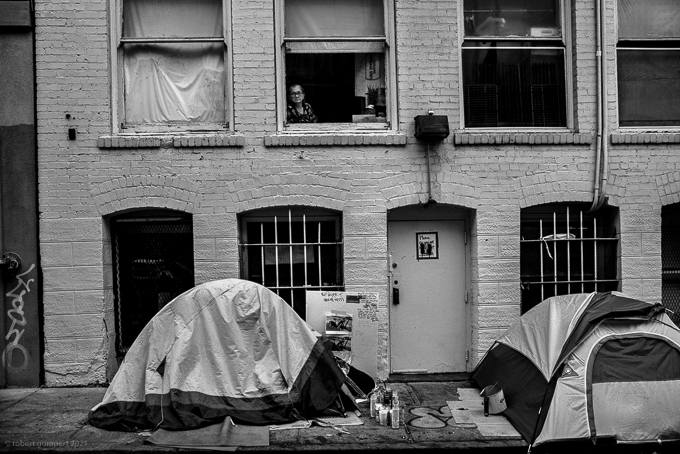Shelter From the Storm
By Brian Edwards
Ooh, a storm is threatening
My very life today
If I don’t get some shelter
Oh yeah, I’m gonna fade away
“Gimme Shelter” -Jagger/Richards
Last weekend, San Francisco endured record rainfall during its first major rainstorm of the year, receiving over 4 inches of rain within the roughly 48 hours that it lasted. The storm had been forecast for over a week and was all over television, internet, and radio. For most locals, news of upcoming rain was good news, as the Bay Area was in the middle of a lengthy statewide drought. The raging wildfires that razed through entire bone-dry North Bay communities in recent years are still fresh in many people’s memories, and a prolonged drought would likely have multiple negative impacts on a state economy already hit hard by the extended pandemic. We needed the water, and the sooner, the better. The rain was forecast to begin on Saturday and subside by Tuesday, and by Friday afternoon before the storm, most San Franciscans had resigned themselves to prepare for a weekend spent indoors with little fuss or fanfare. Slow cooker recipes were downloaded during lunch breaks, Instacart grocery orders were placed, and Netflix queues were added to.
But the city’s homeless people and advocates, along with staff at the Department of Emergency Management (DEM), the Department of Public Health (DPH) and the Department of Homelessness and Supportive Housing (HSH), were getting nervous. The storm was expected to bring high winds, flooding and near-freezing temperatures to the Bay Area, a combination which can be deadly for anyone caught outside and is always absolutely miserable. The first rains were projected to start falling around noon on Saturday, with the heaviest rains and winds beginning on Sunday morning and lasting through Tuesday morning. Advocates and service providers tend to estimate San Francisco’s unhoused population to be 10,000 or more, though the Point-In-Time (PIT) count offers a more conservative estimate of 8,000. Many of these folks lack access to TV or radio. Internet-enabled mobile phones tend to get lost or stolen easily on the street. Mother Nature was about to blow some serious chaos at SF’s most vulnerable residents, and many of them might not be aware she was coming. Even those who did had little chance of getting out of her way and members of the Homeless Outreach Team (SFHOT) along with the City’s service providers had already spent days and nights focusing efforts on spreading warnings of the upcoming storm to folks in encampments and doorways all across the City, along with distributing emergency food, water, ponchos, blankets and socks. With the storm less than 24 hours away, City leaders had elected to try to open the first inclement weather shelter expansion in over a year that weekend but were still scrambling to nail down staffing and logistics. It was almost 9 p.m. on Friday by the time HSH was able to announce the emergency expansion of shelter to their email list, long after most of the City’s service providers and outreach workers had gone home for the weekend.
Shelter from the storm was available, along with hot meals and opportunities to link up with services, but how the hell were people going to find out? The City hadn’t had an inclement weather expansion for two years, and no one outdoors was expecting one to come. HSH’s Twitter feed doesn’t exactly trend, and online efforts to reach folks only go so far. Many of those who weren’t lucky enough to be able to ride the storm out in one of the City’s FEMA-funded hotel rooms, which had been doled out months before, had learned to expect little in terms of meaningful relief from the City over the last year and a half, and few were going to spend much time looking for any. If the City wanted people to know help was available, the City was going to have to bring that message to them in person. They wouldn’t be easy to reach, years of
enforcement against public encampments had taught them to spread and scatter in order to escape the City’s police cruisers and crusher trucks. Many had hunkered down in out-of-the-way places in advance of the storm. The City would have to find them first. SFHOT had the advantage of already knowing where many folks had hidden away, but there were only six out-reachers scheduled to work on Saturday, and only four on Sunday. The team members also had survival gear to distribute as well as word to spread, and both tasks seemed daunting.
SFHOT weren’t alone. SF’s advocates and service providers are long used to filling in the gaps and finding ways to collaborate and complement the efforts of a frustratingly under-resourced City. Many of us also have blurred work-life boundaries and social lives that barely exist, so weekends mean little. By Saturday morning, Signal groups and inboxes began filling up across the City with messages notifying friends, neighbors and co-workers of the additional resources available. Some nonprofits also had staff scheduled to work over the weekend and began to join the efforts. The rains began on time Saturday afternoon, though, and by the time SFHOT ended its shift on Saturday evening and went home, thousands of unhoused San Franciscans hadn’t been reached, and fewer than a dozen people had elected to take advantage of a mat indoors away from the rain.
It didn’t look good.
“I can’t wait until I can shout down whatever City employee says in a Zoom that the empty rain shelters during this storm prove that homeless folks don’t want help or resources,” I texted a friend on Saturday night. San Francisco has a history of failed attempts at messaging and communication with its unhoused residents, and it looked like this storm was going to add to that pile.
But Sunday was a new day. Case managers and hospital social workers who had been forwarded one of Saturday’s emails or text messages began calling and advocating for clients and patients. Unhoused residents and volunteers from Coalition on Homelessness workgroups and mutual aid organizations joined staff from local nonprofits, including Glide, Mother Brown’s and Urban Alchemy in the push to get the word out. The rain and the winds kicked up harder, but SFHOT’s skeleton crew of outreach workers battled downed trees and flooded streets throughout the afternoon to connect with more people, and at 5:31 p.m., I got a text message from the SFHOT manager: “Moscone Full.” I was going to have to wait for a different opportunity to shout at a City employee on Zoom.
In the end, 100 San Franciscans were able to get relief from the wind and rain at an Urban Alchemy-staffed emergency pop-up shelter located inside the Moscone Center, plus 40 more at ECS’s Sanctuary shelter in SoMa. Filling a pop-up shelter to capacity is difficult even outside of a pandemic and with triple the amount of time and resources available. Last weekend, with a fairly sizable assist from the community, SFHOT knocked it out of the ballpark, and Mayor London Breed and HSH Director Shirleen McFadden owe them a round of drinks.

For thousands more last weekend was just like any other during the last 18 months, and they were screwed — left outside to freeze and soak. Dozens of beds at the City’s regular congregate shelter sites were empty on each night of the storm and weren’t available to be filled. And unless the City makes a major change to the way they allot and fill shelter beds, anyone living outside on whatever day you’re reading this has a tiny fraction of the chance of getting a shelter bed that they would have had during any night of the storm.
With multiple emergency shelter sites closing down at the beginning of the COVID-19 pandemic, and the rest reducing capacity by 50% or more, San Francisco’s shelter-in-place order almost immediately translated to “stranded in place” for those forced to sleep outdoors. Homelessness is never easy, but it was especially challenging for anyone experiencing it in 2020. Service providers reduced or eliminated hours, and drop-in facilities closed. Mobile pop-up sites and outreach operations at those providers also halted, sometimes for months. Residential and commercial buildings instituted strict no-visitor policies. San Franciscans were told to limit physical contact and exposure to a handful of people in their social “bubble.” For the better part of 2020, homelessness instantly became a 24/7 lockout for thousands of San Francisco residents, with no opportunity to escape indoors for even a moment of relief. Last December, it was not at all uncommon to run into folks who hadn’t been able to shower for nine months and who had given up trying to find places to charge their phones.
Homeless shelters aren’t perfect anywhere and aren’t for everyone. They never have been, but they’re still an integral part of any community’s efforts in tackling homelessness and reducing some of the harm of living unhoused. Before the pandemic, San Francisco’s single adult shelter system had the capacity to offer over 2,000 San Franciscans the safety of being indoors on any given night, or a little over 20% of its unhoused residents, according to the 2019 PIT count. COVID-19’s effect on the system, along with the safety and respite it offered was almost immediate and has been devastating. New intakes at sites were halted within days of the March 17, 2021, SIP order — if you weren’t already in the system, you weren’t getting in, and subsequent outbreaks at multiple sites soon showed that “in” didn’t necessarily mean “safe.” With intakes halted, the City quietly eliminated the single adult shelter waitlist and moved the shelter sites onto a new occupancy management database. Unhoused residents could no longer call 311, drop into Glide, or check in with a County Adult Assistance Program worker for a shelter bed. In fact, all self-referral pathways to a spot at one of the City’s alternative emergency shelter sites were gone, and nearly a year and a half later, the City shows little sign of any intent to restore a low-barrier self-directed pathway from the streets into a traditional or Navigation Center shelter bed. The system that could once accommodate 2,000 is now limited to 962 as of this writing.
For most of the first year of the pandemic, shutting off congregate shelters to self-referral made sense. Outbreaks at shelter sites across the country and in Europe showed that congregate settings were not safe places to be. Through the Healthy Streets Operation Center (HSOC), the City pivoted to mainly offering two new forms of emergency shelter for a while — hotel rooms and Safe Sleep sites, where individuals or pairs of people live in separate tents. Both were wildly popular among homeless residents, with rooms in San Francisco’s SIP hotels having a 97% acceptance rate among those who were offered one, according to a presentation made by former HSOC director Jeff Kositsky. But new intakes to the SIP hotels ended earlier this year, and several sites have already closed down, with about 1,400 people remaining inside, according to testimony shared at the Board of Supervisors Budget and Finance Committee meeting on October 27. More sites are scheduled to close later this year, and advocates and providers are currently locked in a battle to get the City to extend and expand the program beyond its September 2022 sunset date. Safe Sleep sites fill up fast, and once filled, reservations at all City sites are now open-ended instead of limited to a maximum of 90 days. That means more security for the folks placed inside of it, but also leads to less turnover, and openings at Safe Sleep sites are extremely rare. These openings are managed directly through HSOC and offered almost exclusively to folks facing immediate displacement during an encampment sweep.
While the lifting of the statewide and local SIP orders earlier this year have allowed providers and businesses to reopen and offer unhoused folks more opportunities to seek relief indoors during the day, SF’s push to get folks off the streets into hotel rooms and sanctioned encampments largely ended after the first 3,000 were placed. Current data on how many people remain outdoors doesn’t exist — the 2021 PIT count was cancelled due to COVID safety concerns, and the City’s own data has been focused on tents instead of individuals for years. But even conservative estimates project a significant rise in homelessness nationwide after the first year of the pandemic. As COVID-related national and local eviction moratoriums expire along with unemployment and other financial assistance, the number of people forced out onto San Francisco streets is sure to rise before it falls, and thousands of San Franciscans will have no other option than sleeping outside at night in tent encampments, parks, sidewalks and doorways.
That’s not to say that there isn’t space for more folks to seek relief from the streets. San Francisco’s congregate shelter system hasn’t had a major outbreak since last year, and by my estimate has had a 20% vacancy rate since July. But spots at those shelters are still offered a handful at a time, with SF General Hospital often getting the majority of any day’s available placements for unhoused residents who are being discharged. HSOC has priority for much of what’s left over, and, as with Safe Sleep placements, offers their allotment exclusively to those facing displacement during encampment resolutions. Anything left over — frequently fewer than five beds per day — gets given out by SFHOT, who have multiple other priorities to juggle, including locating folks outside of the SIP hotel system who are eligible to receive housing and responding to calls about people in distress. One might think that a City with more than 10,000 unhoused residents would have an outreach force of hundreds, but SFHOT numbers just about 60. The City asks a lot of them in the best of times, but the expectations and responsibilities for SFHOT during COVID can be overwhelming and exhausting to even watch. The 311 waitlist remains offline, and workers at drop-ins and other community-based nonprofits are still without direct access to reservations at any of the City’s shelter sites. Unhoused San Franciscans seeking shelter or those advocating for them can leave a voicemail with SFHOT, and if they’re lucky enough — and early enough —, they can connect with an outreach worker to land one of the few spots that HSOC makes available on any given day. SFHOT’s commitment to following up on calls they receive is genuine, and other advocates and I have worked with them successfully dozens of times this year to get folks off the streets into alternative shelter. But many folks have been on the streets for years, and SFHOT hasn’t always been so diligent. Those folks often have little faith in follow-through, and most unhoused people aren’t even aware that there is a voicemail to call. Also, there’s no guarantee that there will be a spot. Often, the surest way for an unhoused person to get into one of the City’s vacant shelter beds is to be in an encampment HSOC targets for displacement. SF is burning out one of its best key resources, while shutting out its community partners and letting 20 percent of its shelter beds go unused each night.
That’s nuts, and it’s also a step backwards towards a system that worked for no one. Before a phone system to reserve beds went live in 2014, people could spend hours each day lining up outside of shelters or waiting in drop-ins hoping to secure that night’s shelter. Code Tenderloin founder and Local Homeless Coordinating Board co-chair Del Seymour told me that when he was homeless, he would often have to waste half a day in one spot waiting, just to see if there was a spot available for him that evening. Many evenings there wasn’t. “It was bullsh*t,” he said.
That system changed in 2012 when former SF homeless czar Bevan Dufty convened the Shelter Access Workgroup, which included providers and unhoused residents from across the city. “With extensive input from unhoused shelter users, lines and waiting rooms were eliminated, and the system changed to the 311 call-in system that made it simple to request a bed that fit your needs,” said Coalition on Homelessness Executive Director Jennifer Friedenbach. “Just a few years later, there is not even a line to wait in, let alone a toll-free number. There’s no way to get in beyond the sheer luck of being in the right place at the right time when a City outreach worker happens to both run into you and have a bed to offer. Unhoused people absolutely must have a way to request shelter themselves.”
The good news is the City already has that way — it’s simple, has worked before and can work again — which brings me back to the storm at the beginning of this article. During the storm, folks were able to walk up to the sites at Moscone and Sanctuary without a reservation, and as long as there was space available, they got in. That’s key. Homeless folks should have as much agency and authority over the resources they accept as the city employees and nonprofit workers who offer them. When you give folks the ability to get into a bed without having SFHOT handle the reservation, you allow folks to make their own decisions at their own speed and on their own terms, and that leads to better outcomes for everyone. Beds fill up fast. The City already has some of the best nonprofit, public health and outreach workers in the world — seriously, they fucking rock. And it has shelter beds. By unburdening SFHOT from being the lone gatekeeper and including community and provider nonprofits in the shelter allocation and distribution process, everyone involved can better use their own resources to complement each other’s efforts, and beds end up being occupied by folks who want them, instead of folks being pressured into them under the shadow of an SF Public Works crusher truck.
Most things aren’t this simple, but this is. I doubt that Mayor Breed or Director McFadden will read this, but just in case:
Restore the single adult shelter waitlist. Let folks call 311 or walk back into Glide or Mother Brown’s to get on it, and start filling those vacant beds, and give ‘em shelter like The Rolling Stones advise. Let service providers and SFHOT each do the things that they’re best at, so they can collaborate and function together as a true community/government partnership. Bring unhoused residents back to the center of the policies and procedures that impact and service them and restore a bit of the sanity we all lost during the pandemic back to the system we live, work or advocate in.
And buy those outreach workers from last weekend a beer.
If you don’t listen to me, listen to Hospitality House director Joe Wilson: “There’s no excuse for people being without shelter in San Francisco. None. We should make it easier — not harder — for people to come inside from the cold. We can do better, and we must, in the City of St. Francis.”
Cheers, Joe.
.
Gimme Shelter originally appeared in Street Sheet, A Publication of the Coalition on Homelessness on 2 November 2021
Personal note from Robert Gumpert, co-editor of the Stansbury Forum:
Brian Edwards was an outreach volunteer and member of the Human Rights working group with the Coalition on Homelessness here in San Francisco. It was on the street that I meet him about 4 or 5 years ago. Committed, resourceful and deeply human, Brian died in the early hours of 4 November 2021, just two days after writing this piece. He will be missed by all those he chanced to meet.
…


